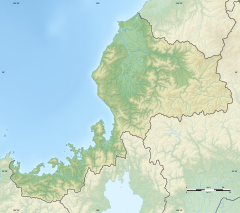| Takidan-ji | |
|---|---|
| 瀧谷寺 | |
 Takidan-ji main hall Takidan-ji main hall | |
| Religion | |
| Affiliation | Buddhism |
| Deity | Yakushi Nyōrai |
| Rite | Shingon-shū Chizan-ha sect |
| Location | |
| Location | 1-7-15 Mikuni-cho Takidan, Sakai-shi, Fukui-ken |
| Country | |
  | |
| Geographic coordinates | 36°13′18.8″N 136°8′46.0″E / 36.221889°N 136.146111°E / 36.221889; 136.146111 |
| Architecture | |
| Completed | 1377 AD |
| Website | |
| www | |
Takidan-ji (瀧谷寺) is a Buddhist temple belonging to the Shingon-shū Chizan-ha sect located in the city of Sakai, Fukui, Japan in the Hokuriku region of Japan. Its main image is a statue of Yakushi Nyōrai, which the temple claims was carved by the Nara period shugendō monk Taichō. The temple is noted for its Japanese garden.
History
Takidan-ji was founded in 1377 AD and moved to its present location in 1381. During the Muromachi period it was patronized by the Asakura clan and during the Sengoku period by Shibata Katsuie. Under the Edo period Tokugawa shogunate, it was patronized by the Matsudaira clan, daimyō of Fukui Domain and had many sub-temples. Following the Meiji restoration, the temple became much reduced in scale. Many of its surviving structures date from the Edo period.
Cultural properties
- Hondō, built in 1688, National Important Cultural Property.
- Sanmon, built in 1698, National Important Cultural Property.
- Kannon-dō, built in the Muromachi period, reconstructed in 1663, National Important Cultural Property.
- Kuri, reconstructed in 1688, National Important Cultural Property
- Chinju-dō, built in the Edo period, National Important Cultural Property.
- Kaisan-dō, built in the Edo period, National Important Cultural Property.
- Kyakuden-dō, built in 1914, Fukui Prefectural Important Cultural Property
- Bianqing Gilt bronze Buddhist ritual gong with hōsōge flower design, late Heian period, National Treasure
- Jizō, Bosatsu Scroll, late Heian period, National Important Cultural Property.
- "Map of the Heavens" Scroll, Muromachi period, National Important Cultural Property.
- Japanese garden adjacent to the Main Hall was designated one of the National Places of Scenic Beauty of Japan in 1967.
-
 Hosoge flower gong
Hosoge flower gong
(NT) -
 Chinju-dō
Chinju-dō
(ICP) -
 Jizo Bosatsu scroll
Jizo Bosatsu scroll
(ICP) -
 Map of the Heavens
Map of the Heavens
(ICP) -
 Kannon-dō
Kannon-dō
(ICP)) -
 Kaisan-dō
Kaisan-dō
(ICP) -
 Sanmon
Sanmon
(ICP)
See also
References
- "瀧谷寺庭園" (in Japanese). Agency for Cultural Affairs.
External links
![]() Media related to Takidanji at Wikimedia Commons
Media related to Takidanji at Wikimedia Commons
- Sakai city tourism site (in Japanese)
- Takidan-ji Official Site (in Japanese)
- Sakai City Official Website

